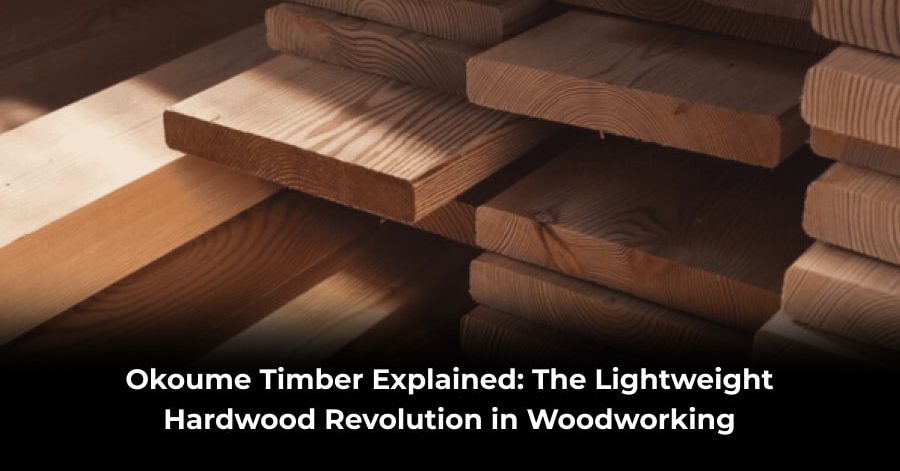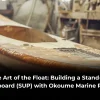Introduction
In the world of woodworking and construction, the type of timber you choose defines not only the durability of your project but also its finish, aesthetics, and overall value. Among the many hardwoods used globally, okoume timber has emerged as a standout material—especially for professionals and hobbyists seeking a combination of light weight, high workability, and visual elegance.
Known for its smooth texture and consistent grain, okoume wood is widely used across various industries, from boat building to cabinetry and interior décor. But what exactly makes this timber so special, and why is it gaining momentum as a preferred hardwood?
In this blog, we dive deep into the world of okoume—its origin, properties, applications, benefits, and why it may just be the perfect choice for your next woodworking project.
What is Okoume Timber?
Okoume timber comes from the Aucoumea klaineana tree, native to Central Africa, particularly Gabon. It is often categorized as a tropical hardwood, though it behaves more like softwood in terms of weight and flexibility. Despite being lightweight, okoume is surprisingly durable and aesthetically appealing.
The timber is light pink to reddish-brown in color with a fine and even grain pattern, making it a favorite for decorative purposes and projects requiring a polished finish.
Characteristics of Okoume Wood
If you’re considering okoume wood for your project, here are its standout features:
- Lightweight: Easier to handle and reduces structural load—ideal for transport and marine applications.
- Fine grain texture: Offers a smooth finish, perfect for staining or varnishing.
- Workability: Machines well and can be easily sawn, sanded, or drilled without splintering.
- Aesthetic appeal: Natural luster and uniform grain enhance visual value.
- Sustainability: Okoume is often harvested from responsibly managed forests in Gabon.
These characteristics make okoume timber a versatile choice for both functional and decorative uses.
Common Uses of Okoume Timber
The application of okoume wood spans multiple industries due to its adaptability and performance.
1. Marine Construction
One of the most common uses of okoume is in boat building. Its light weight and ability to be laminated make it ideal for hulls, decks, and interiors of watercraft.
2. Plywood Production
Okoume is extensively used in manufacturing plywood—especially marine-grade plywood—due to its uniformity and bonding strength.
3. Furniture Making
Thanks to its fine finish and easy handling, okoume is favored in crafting custom furniture, cabinetry, and shelving.
4. Interior Paneling and Décor
Its appealing texture and color make it a popular choice for wall cladding, ceiling panels, and architectural features.
5. Acoustic Applications
Because of its light density, okoume is sometimes used in speaker boxes and musical instruments where tonal quality matters.
Okoume vs Other Timber Options
| Feature | Okoume Timber | Teak | Meranti | Maple |
| Weight | Very light | Heavy | Medium weight | Medium-heavy |
| Workability | Excellent | Moderate | Good | Good |
| Water Resistance | Good (when sealed) | Excellent | Fair | Fair |
| Appearance | Light pink, fine grain | Dark, coarse grain | Reddish, coarse grain | Pale, smooth grain |
| Cost | Moderate | High | Moderate | High |
For applications where weight, cost-effectiveness, and finish quality are key, okoume wood outperforms many other hardwood options.
Benefits of Using Okoume Timber
Choosing okoume timber for your project comes with a range of benefits:
✅ Ease of Use
Its low density means it’s easier to transport, cut, and assemble. This saves labor costs and shortens construction timelines.
✅ Superior Aesthetic Value
Okoume accepts stains, veneers, and paints exceptionally well, giving builders creative freedom for final finishes.
✅ Environmentally Friendly
Much of the okoume wood exported from Gabon is certified by sustainable forestry organizations, supporting eco-conscious construction.
✅ Versatile Performance
Whether indoors or out (with proper treatment), okoume performs well under a variety of conditions, especially in marine and humid environments.
Considerations When Working with Okoume
While okoume is an excellent choice in many scenarios, it’s important to consider a few precautions:
- Not naturally water-resistant: It needs to be sealed or treated for outdoor or marine use.
- Softer than other hardwoods: Though classified as a hardwood, it’s less dense and may not be suitable for high-impact structural components.
- Limited color variation: For those seeking dramatic wood tones, okoume’s consistent color may be too subtle.
Still, when used appropriately, okoume timber is a high-value, reliable material that offers a great return on investment.
How to Source Okoume Wood
Whether you’re purchasing raw lumber or okoume timber in the form of plywood or panels, sourcing from the right supplier is essential.
Look for:
- Certified Suppliers: Choose vendors who provide FSC-certified okoume for sustainable sourcing.
- Moisture-Controlled Stock: Kiln-dried timber reduces the risk of warping or cracking.
- Clear Grading Information: Ask about the timber grade to ensure quality standards for your specific use.
- Customization Options: Some suppliers offer cutting, sizing, or finishing services for added convenience.
Reputable vendors will offer transparent pricing, detailed product specifications, and client support to help you select the right wood for your project.
Okoume Timber in Sustainable Construction
As sustainable building practices become the norm, the role of eco-friendly timber like okoume is expanding. Many modern builders are choosing okoume wood not only for its technical merits but also for its alignment with green certification programs such as LEED and BREEAM.
With increasing access to responsibly sourced materials and the availability of eco-certifications, okoume has become a smart choice for environmentally-conscious projects without compromising on performance or beauty.
Final Thoughts
When it comes to selecting timber that balances affordability, aesthetics, and functionality, few options rival okoume timber. Lightweight yet strong, beautiful yet workable, this tropical hardwood opens doors for creativity and quality craftsmanship in equal measure.
Whether you’re crafting bespoke furniture, designing boat interiors, or searching for the perfect paneling material, okoume wood delivers on all fronts. The key lies in understanding its properties, applying the right finishes, and sourcing from reputable suppliers.
Ready to explore the possibilities of okoume for your next project? You might just find it’s the perfect material you didn’t know you needed.






